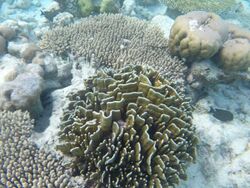Biology:Blue coral
| Blue coral | |
|---|---|

| |
| Scientific classification | |
| Domain: | Eukaryota |
| Kingdom: | Animalia |
| Phylum: | Cnidaria |
| Class: | Octocorallia |
| Order: | Helioporacea |
| Family: | Helioporidae |
| Genus: | Heliopora |
| Species: | H. coerulea
|
| Binomial name | |
| Heliopora coerulea Pallas, 1766
| |
Blue coral (Heliopora coerulea) is a species of colonial coral. It is the only octocoral known to produce a massive skeleton.[2] This skeleton is formed of aragonite, similar to that of scleractinia. Individual polyps live in tubes within the skeleton and are connected by a thin layer of tissue over the outside of the skeleton.
Description
The blue coral is the only extant octocoral with a massive skeleton,[2] which is composed of fibrocrystalline aragonite (calcium carbonate). It is a hermatypic zooxanthellaete species with either blue or grey-grey polyps located within its skeleton, which each contain eight tentacles. Its colonies are either columnar, plates or branched.[3][4] It is a tolerant species and is used in marine aquariums.
Iron salts give the skeleton of Heliopora coerulea its unique color, which allows for easy recognition in fossil outcrops.[5] As such, it is fairly abundant within paleontology, with fossils indicating the species has remained unchanged since the Cretaceous.[5]
-
Live colony
-
Close-up on live polyps (notice the 8 arms)
-
Preserved skeletton, showing the typical color
-
idem
-
Close-up.
Distribution
Despite being common in some areas and having a large range, the blue coral has been given the conservation status of a vulnerable species by the IUCN. Its population is unknown but it is believed to be decreasing in line with the global destruction of coral reefs; it is threatened by aquarium harvesting, bleaching, habitat destruction, the acidification of oceans, and climate change.[1] It is found in the eastern and western Indian Ocean, and the eastern central, western central, northwestern, and southwestern Pacific Ocean; its range includes the Great Barrier Reef, Australia, Japan and the Ryukyu Islands. Its largest colony is believed to be located off Ishigaki Island in the Yaeyama Islands, southwestern Japan. It is found in reefs with depths below 2 m, or reefs exposed to waves, flats, intertidal regions, and sometimes in marginal habitats.[1] The blue coral is listed under CITES Appendixes I and II.[1]
Taxonomy
Heliopora coerulea was described by Pallas in 1766.[6]
References
- ↑ 1.0 1.1 1.2 1.3 Obura, D.; Fenner, D.; Hoeksema, B.; Devantier, L.; Sheppard, C. (2008). "Heliopora coerulea". IUCN Red List of Threatened Species 2008: e.T133193A3624060. doi:10.2305/IUCN.UK.2008.RLTS.T133193A3624060.en. https://www.iucnredlist.org/species/133193/3624060.
- ↑ 2.0 2.1 Barnes, Robert D. (1982). Invertebrate Zoology. Philadelphia, PA: Holt-Saunders International. p. 169. ISBN 0-03-056747-5.
- ↑ "Heliopora coerulea". Arkive.org. http://www.arkive.org/blue-coral/heliopora-coerulea/.
- ↑ Leon P. Zann; Lesley Bolton (September 1985). "The distribution, abundance and ecology of the blue coral Heliopora coerulea (Pallas) in the Pacific". Coral Reefs 4 (2): 125–134. doi:10.1007/BF00300871.
- ↑ 5.0 5.1 Gornitz, V (2009). Encyclopedia of Paleoclimatology and Ancient Environments. Springer. pp. 202–203. ISBN 978-1402045516. https://archive.org/details/encyclopediapale00gorn.
- ↑ "Heliopora coerulea". World Register of Marine Species. http://www.marinespecies.org/aphia.php?p=taxdetails&id=210725.
External links
- "Heliopora coerulea". Integrated Taxonomic Information System. https://www.itis.gov/servlet/SingleRpt/SingleRpt?search_topic=TSN&search_value=52077.
Wikidata ☰ Q1056942 entry








